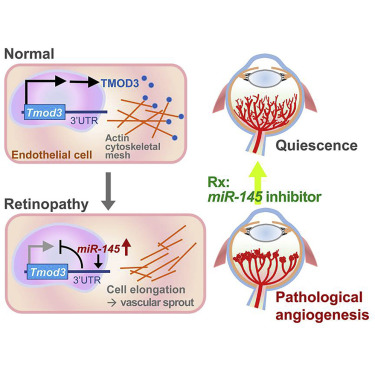当前位置:
X-MOL 学术
›
Mol. Ther. Nucl. Acids
›
论文详情
Our official English website, www.x-mol.net, welcomes your
feedback! (Note: you will need to create a separate account there.)
MicroRNA-145 Regulates Pathological Retinal Angiogenesis by Suppression of TMOD3
Molecular Therapy - Nucleic Acids ( IF 6.5 ) Pub Date : 2019-03-21 , DOI: 10.1016/j.omtn.2019.03.001 Chi-Hsiu Liu , Zhongxiao Wang , Shuo Huang , Ye Sun , Jing Chen
Molecular Therapy - Nucleic Acids ( IF 6.5 ) Pub Date : 2019-03-21 , DOI: 10.1016/j.omtn.2019.03.001 Chi-Hsiu Liu , Zhongxiao Wang , Shuo Huang , Ye Sun , Jing Chen

|
Pathological angiogenesis is a hallmark of various vascular diseases including vascular eye disorders. Dysregulation of microRNAs (miRNAs), a group of small regulatory RNAs, has been implicated in the regulation of ocular neovascularization. This study investigated the specific role of () in regulating vascular endothelial cell (EC) function and pathological ocular angiogenesis in a mouse model of oxygen-induced retinopathy (OIR). Expression of was significantly upregulated in OIR mouse retinas compared with room air controls. Treatment with synthetic inhibitors drastically decreased levels of pathological neovascularization in OIR, without substantially affecting normal developmental angiogenesis. In cultured human retinal ECs, treatment with mimics significantly increased the EC angiogenic function, including proliferation, migration, and tubular formation, whereas inhibitors attenuated angiogenesis. Tropomodulin3 (TMOD3), an actin-capping protein, is a direct target and is downregulated in OIR retinas. Treatment with mimic led to TMOD3 inhibition, altered actin cytoskeletal architecture, and elongation of ECs. Moreover, inhibition of TMOD3 promoted EC angiogenic function and pathological neovascularization in OIR and abolished the vascular effects of inhibitors and . Overall, our findings indicate that is a novel regulator of TMOD3-dependent cytoskeletal architecture and pathological angiogenesis and a potential target for development of treatments for neovascular eye disorders.
中文翻译:

MicroRNA-145 通过抑制 TMOD3 调节病理性视网膜血管生成
病理性血管生成是包括血管性眼病在内的各种血管疾病的标志。 microRNA (miRNA) 是一组小调节 RNA,其失调与眼部新生血管形成的调节有关。本研究探讨了 () 在氧诱导性视网膜病变 (OIR) 小鼠模型中调节血管内皮细胞 (EC) 功能和病理性眼部血管生成的具体作用。与室内空气对照相比,OIR 小鼠视网膜中 的表达显着上调。使用合成抑制剂治疗可显着降低 OIR 中病理性新血管形成的水平,而不会显着影响正常的发育性血管生成。在培养的人视网膜内皮细胞中,用模拟物治疗显着增加了内皮细胞的血管生成功能,包括增殖、迁移和管状形成,而抑制剂则减弱了血管生成。原调节蛋白 3 (TMOD3) 是一种肌动蛋白加帽蛋白,是 OIR 视网膜的直接靶标并被下调。模拟物治疗导致 TMOD3 抑制、肌动蛋白细胞骨架结构改变和 EC 伸长。此外,抑制TMOD3可促进OIR中EC的血管生成功能和病理性新血管形成,并消除抑制剂和的血管作用。总的来说,我们的研究结果表明,它是 TMOD3 依赖性细胞骨架结构和病理性血管生成的新型调节剂,也是开发新生血管性眼部疾病治疗的潜在靶标。
更新日期:2019-03-21
中文翻译:

MicroRNA-145 通过抑制 TMOD3 调节病理性视网膜血管生成
病理性血管生成是包括血管性眼病在内的各种血管疾病的标志。 microRNA (miRNA) 是一组小调节 RNA,其失调与眼部新生血管形成的调节有关。本研究探讨了 () 在氧诱导性视网膜病变 (OIR) 小鼠模型中调节血管内皮细胞 (EC) 功能和病理性眼部血管生成的具体作用。与室内空气对照相比,OIR 小鼠视网膜中 的表达显着上调。使用合成抑制剂治疗可显着降低 OIR 中病理性新血管形成的水平,而不会显着影响正常的发育性血管生成。在培养的人视网膜内皮细胞中,用模拟物治疗显着增加了内皮细胞的血管生成功能,包括增殖、迁移和管状形成,而抑制剂则减弱了血管生成。原调节蛋白 3 (TMOD3) 是一种肌动蛋白加帽蛋白,是 OIR 视网膜的直接靶标并被下调。模拟物治疗导致 TMOD3 抑制、肌动蛋白细胞骨架结构改变和 EC 伸长。此外,抑制TMOD3可促进OIR中EC的血管生成功能和病理性新血管形成,并消除抑制剂和的血管作用。总的来说,我们的研究结果表明,它是 TMOD3 依赖性细胞骨架结构和病理性血管生成的新型调节剂,也是开发新生血管性眼部疾病治疗的潜在靶标。































 京公网安备 11010802027423号
京公网安备 11010802027423号